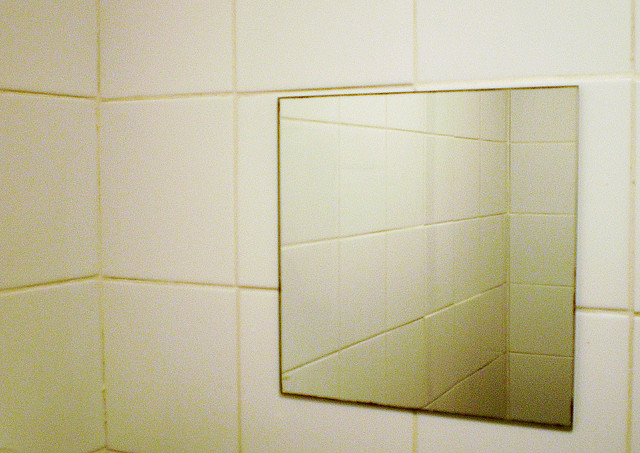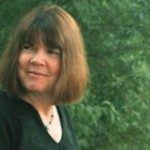 I stop by the restroom after my first class and catch a glimpse of my stark reflection in the mirror. Under the fluorescent lights my reflection looks unfamiliar—the color of my hair lurid and artificial, my face pale and drained of life. Is this what I look like in the classroom too? Lately I’m startled at how much I’ve aged. Puffy circles under my eyes. Broken blood vessels on my cheeks. Crepey jowls under my chin. Jowls. Who could have imagined that? But then who could have imagined that one day I’d be sixty, with a long-term marriage, a son out of college, a 30-year mortgage, and a full-time job that I often resent.
I stop by the restroom after my first class and catch a glimpse of my stark reflection in the mirror. Under the fluorescent lights my reflection looks unfamiliar—the color of my hair lurid and artificial, my face pale and drained of life. Is this what I look like in the classroom too? Lately I’m startled at how much I’ve aged. Puffy circles under my eyes. Broken blood vessels on my cheeks. Crepey jowls under my chin. Jowls. Who could have imagined that? But then who could have imagined that one day I’d be sixty, with a long-term marriage, a son out of college, a 30-year mortgage, and a full-time job that I often resent.
There’s no time for lunch between classes, so I gulp down a yoghurt at my desk, trying to read my emails at the same time, flipping through a stack of student papers I’ll need to grade tomorrow. I tell four students that they’ll have to come back to my office hour for advising. I try not to be annoyed when two of them delay me in the hall. I like my students, working class kids at an under-funded public university. It’s not their fault that there aren’t enough advisors, enough courses, that the wait lists are so long, that the state budget so abysmal. I check my watch and rush off to my second class.
Today I’m teaching a series of mirror scenes in Edith Wharton’s novel House of Mirth. They can mean different things, I suggest. You might look in the mirror to admire yourself. (I think of Milton’s Eve, and Narcissus. Vanity is apparently dangerous.) You might look in a mirror to check on your appearance to others, put on your public face. (I think of an old woman admiring a sultry movie star as she blots her bright red lips—oblivious to the wrinkled crone with garish, crooked lipstick that others see. Already my imagination is falling into the cracks of our discussion of the novel. There are a lot of things I’m not saying, including of course how I feel when I look in the mirror myself.) Wharton’s Lily Bart adjusts her hat and veil in the mirror at Lawrence Selden’s apartment, ready to sweep out into public and dazzle the world with her beauty. That night she checks the mirror and worries about the fine lines around her mouth. Is it so apparent that she is getting older? Determined to marry a wealthy man, Lily depends on her beauty to achieve that end, and becomes progressively more anxious, as this commodity-driven novel unfolds, about her chief asset. Mirror scenes may go even deeper, though, beyond appearances. You might look in the mirror to confront who you are. After the reckoning with Gus Trenor, Lily feels a kind of moral horror. When she looks in the mirror she sees something monstrous.
I stay focused on Wharton in the discussion, but I’m reflecting on other mirror scenes. Snow White’s wicked stepmother gazes in the glass and can’t refrain from comparing herself to other women. “Mirror, mirror on the wall, who’s the fairest of them all?” Not a good question; sooner or later you’re not going to like the answer. Virginia Woolf calls the early guilt she felt in front of the mirror her “looking glass shame,” a shame that lasted her entire life: “I must have been ashamed or afraid of my own body.” Woolf was molested, also anorexic. Do all women feel shame at some point, or do some take lifelong delight in their bodies? Not me. I bring my straying attention back to class. Discussion is animated in the front and on the right side of the room, but there’s a student text-messaging in the back row, another surreptitiously reading a textbook for another class, another checking her makeup in a lipstick-compact mirror, and I wonder if they’ve been listening at all.
I rush to yoga after my crowded office hour and arrive home feeling calm and pleasantly spacey, my senses heightened. Dinner by candlelight with my husband is an oasis, though I can’t refrain, it seems, from talking about work. He’s better at shedding the day than I am. I wonder what my life would be like, what our lives would be like, without the warm reflections of ourselves that we see in each other’s eyes. In the waning light after we finish up the dishes, I go outside to break off a deep pink camellia from the small tree by the front gate, and a small branch of fuzzy yellow flowers from a tree by the driveway—I don’t even know what the tree is called. I spend some time choosing a pottery vase, and put them on the windowsill in front of the sink. The immigrant mother of a school friend of my son’s said the trees were all over the Ukraine. She remembered gathering armfuls of flowering branches as a girl. They always reminded her of her homeland, she said. The woman’s memory has created a kind of nostalgia for me, though I have no girlhood memories of this tree. I’ve come to appreciate the tree’s bounteous beauty, to feel a kind of celebration and mourning of my own youth when it blooms each year now.
I look in the mirror as I brush my teeth for bed. The dim bathroom light softens my features. Even with toothpaste foaming out of my mouth, I don’t look so bad. I smile to myself when I think of the students in my classes today, faces lit up during the lively discussion, and the students in my office hour later, who left feeling better about their problems or their futures. I think about how close I’ve become to my son, despite our geographical distance. I think about what I’m teaching and writing, and how much I share with my husband. I think about the flowers on the windowsill in the kitchen, already dropping their petals, but beautiful just the same.
 Jacqueline Doyle lives in the San Francisco Bay Area, where she has taught for many years at a state university. Her creative nonfiction is published and forthcoming in South Dakota Review, Thin Air, Frontiers, Women’s Studies, New Plains Review, elimae, Bluestem Quarterly, Sweet, Birkensnake, and South Loop Review, among others. She recently won Ninth Letter‘s online meta-essay contest. Visit her here.
Jacqueline Doyle lives in the San Francisco Bay Area, where she has taught for many years at a state university. Her creative nonfiction is published and forthcoming in South Dakota Review, Thin Air, Frontiers, Women’s Studies, New Plains Review, elimae, Bluestem Quarterly, Sweet, Birkensnake, and South Loop Review, among others. She recently won Ninth Letter‘s online meta-essay contest. Visit her here.



Well written, meaningful, lovely essay and a beautiful picture, too!